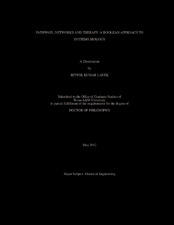| dc.contributor.advisor | Datta, Aniruddha | |
| dc.contributor.advisor | Dougherty, Edward R. | |
| dc.creator | Layek, Ritwik | |
| dc.date.accessioned | 2012-07-16T15:57:49Z | |
| dc.date.accessioned | 2012-07-16T20:27:52Z | |
| dc.date.available | 2014-09-16T07:28:20Z | |
| dc.date.created | 2012-05 | |
| dc.date.issued | 2012-07-16 | |
| dc.date.submitted | May 2012 | |
| dc.identifier.uri | https://hdl.handle.net/1969.1/ETD-TAMU-2012-05-10829 | |
| dc.description.abstract | The area of systems biology evolved in an attempt to introduce mathematical systems theory principles in biology. Although we believe that all biological processes are essentially chemical reactions, describing those using precise mathematical rules is not easy, primarily due to the complexity and enormity of biological systems. Here we introduce a formal approach for modeling biological dynamical relationships and diseases such as cancer. The immediate motivation behind this research is the urgency to find a practicable cure of cancer, the emperor of all maladies. Unlike other deadly endemic diseases such as plague, dengue and AIDS, cancer is characteristically heterogenic and hence requires a closer look into the genesis of the disease. The actual cause of cancer lies within our physiology. The process of cell division holds the clue to unravel the mysteries surrounding this disease. In normal scenario, all control mechanisms work in tandem and cell divides only when the division is required, for instance, to heal a wound platelet derived growth factor triggers cell division. The control mechanism is tightly regulated by several biochemical interactions commonly known as signal transduction pathways. However, from mathematical point of view, these pathways are marginal in nature and unable to cope with the multi-variability of a heterogenic disease like cancer.
The present research is possibly one first attempt towards unraveling the mysteries surrounding the dynamics of a proliferating cell. A novel yet simple methodology is developed to bring all the marginal knowledge of the signaling pathways together to form the simplest mathematical abstract known as the Boolean Network. The malfunctioning in the cell by genetic mutations is formally modeled as stuck-at faults in the underlying Network. Finally a mathematical methodology is discovered to optimally find out the possible best combination drug therapy which can drive the cell from an undesirable condition of proliferation to a desirable condition of quiescence or apoptosis. Although, the complete biological validation was beyond the scope of the current research, the process of in-vitro validation has been already initiated by our collaborators. Once validated, this research will lead to a bright future in the field on personalized cancer therapy. | en |
| dc.format.mimetype | application/pdf | |
| dc.language.iso | en_US | |
| dc.subject | Systems Biology | en |
| dc.subject | Boolean Network | en |
| dc.subject | Probabilistic Boolean Network | en |
| dc.subject | Markov Chain | en |
| dc.subject | State transition diagram | en |
| dc.subject | Dynamic Programming | en |
| dc.subject | Therapeutic Intervention | en |
| dc.subject | Karnaugh Map | en |
| dc.subject | Signal Transduction Pathways | en |
| dc.subject | Regulatory Networks | en |
| dc.subject | DNA damage pathways | en |
| dc.subject | P53 | en |
| dc.subject | Cancer | en |
| dc.subject | Cell Cycle | en |
| dc.subject | Growth Factor Mediated Pathways | en |
| dc.subject | Targeted Therapy | en |
| dc.subject | Combination Drug | en |
| dc.subject | Genetic Mutation | en |
| dc.subject | Stuck-at Faults | en |
| dc.subject | Fault Detection | en |
| dc.subject | Fault Classification | en |
| dc.title | Pathways, Networks and Therapy: A Boolean Approach to Systems Biology | en |
| dc.type | Thesis | en |
| thesis.degree.department | Electrical and Computer Engineering | en |
| thesis.degree.discipline | Electrical Engineering | en |
| thesis.degree.grantor | Texas A&M University | en |
| thesis.degree.name | Doctor of Philosophy | en |
| thesis.degree.level | Doctoral | en |
| dc.contributor.committeeMember | Bhattacharyya, Shankar P. | |
| dc.contributor.committeeMember | Sivakumar, N | |
| dc.type.genre | thesis | en |
| dc.type.material | text | en |
| local.embargo.terms | 2014-07-16 | |


